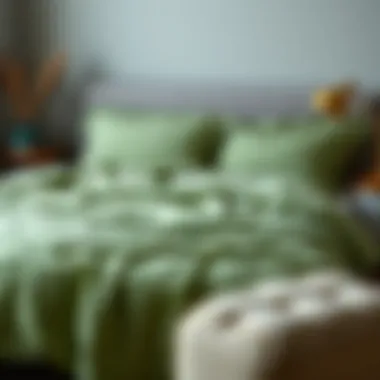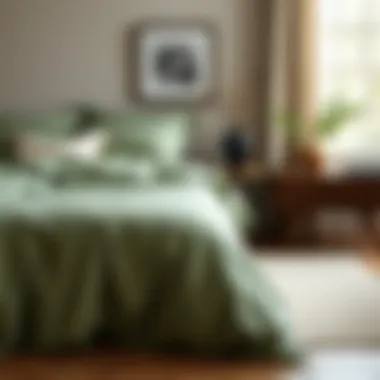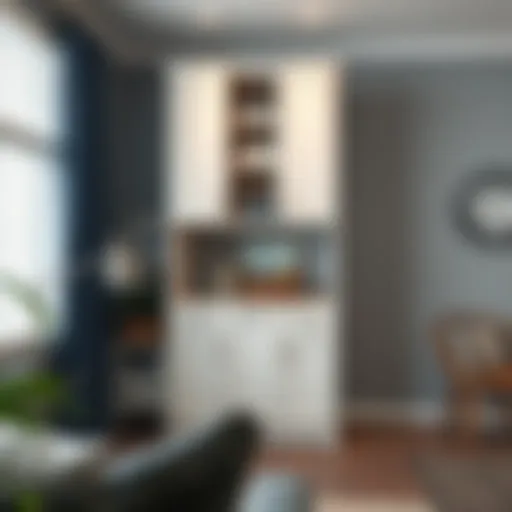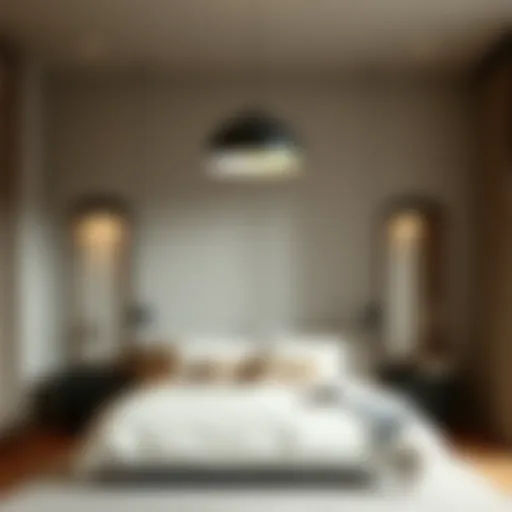Comprehensive Guide to Green Linen Duvet Covers


Intro
In the world of home textiles, a green linen duvet cover is not just a mere fabric; it embodies a blend of style, sustainability, and comfort. For homeowners looking to infuse their bedrooms with a touch of nature, this option provides the perfect gateway. Linen, renowned for its breathability and durability, marries beautifully with the vibrant hues of green, making it a standout choice for queen-sized beds. Through the course of this article, readers will uncover invaluable insights into the benefits of choosing linen, various design options that complement green hues, and practical maintenance tips that ensure longevity. Moreover, the discussion extends into the importance of eco-friendly fabric choices and how these can align with modern decor trends.
As we bed down this journey, expect to find a detailed tapestry of information aimed at enhancing your sleeping space—whether you’re a DIY aficionado, a seasoned designer, or just someone with a passion for stylish living. Let's pull back the covers on this topic.
Prelims to Green Linen Duvet Covers
When it comes to designing a bedroom, every detail counts, and one of the focal points in any sleep sanctuary is the duvet cover. A green linen duvet cover encapsulates a blend of style, comfort, and sustainability that appeals to modern homeowners and design aficionados alike. This particular hue not only brings a refreshing aesthetic but also offers various benefits that set it apart from other bedding options.
Understanding the significance of green linen duvet covers involves recognizing both their aesthetic charm and functional attributes. Green is often associated with nature, representing growth, renewal, and tranquility. In a world that feels increasingly chaotic, enveloping yourself in bedding that reflects the soothing tones of the natural world can foster a peaceful atmosphere in your bedroom.
But it's not just the color that makes these duvet covers noteworthy. Linen is celebrated for its breathability and durability. This fabric has been cherished for centuries, and its characteristics make it an excellent choice for bedding. Additionally, in today's eco-conscious society, opting for linen contributes to a more sustainable lifestyle, as the production of linen has a more minimal environmental footprint compared to traditional cotton.
Opting for a green linen duvet cover also gives a nod to contemporary design trends, offering versatility in styling. Whether paired with neutral tones or bold accents, the options are virtually limitless. It can complement various home decors, from minimalist to bohemian styles.
In essence, the exploration of green linen duvet covers serves as a fascinating intersection of fashion, function, and sustainability. This article aims to unravel the diverse layers of this bedding choice, guiding homeowners and designers in making informed decisions that enhance their space's aesthetics and comfort.
"A room should never allow the eye to settle in one place. It should smile at you and create fantasy."
— Paul V. Gallico
Thus, as we delve into the fabric's characteristics, color psychology, and maintenance, the allure of green linen bedding will become clear, highlighting its importance not just as a decorative element but as a fundamental part of creating a serene sanctuary at home.
The Material: Understanding Linen
The choice of material significantly impacts the overall quality and aesthetic of any bedding, and when it comes to duvet covers, linen stands out as a top contender. This section dives into the intrinsic characteristics of linen, revealing why it's celebrated among homeowners and designers alike.
Linen Characteristics
Natural and Breathable Fabric
Linen is crafted from the fibers of the flax plant and is inherently designed to breathe. This characteristic is crucial in a duvet cover, as it allows for better air circulation, making it an excellent option for both warm and cool climates. The breathability ensures a comfortable sleep environment and reduces the risk of overheating during the night.
The unique structure of linen fibers also contributes to its absorbent nature, allowing it to wick away moisture efficiently. This means, even during the warmest nights, a green linen duvet cover offers a private escape that’s cool and dry. The natural feel of the fabric provides a cozy embrace for sleep enthusiasts.
Durability and Longevity
One can't overlook the durability of linen. Unlike cotton, which may show signs of wear and tear over time, linen is known for its strength. It can withstand multiple washes without losing its integrity, which makes it a popular choice for those looking for bedding that investment will stand the test of time. The fibers become softer with each wash, adding to its appeal.
A green linen duvet cover, therefore, not only enhances the visual appeal of a bedroom but also proves itself as a steadfast companion over the years. Investing in such a fabric means one is not just purchasing a cover but adding a lasting piece to their home collection.
Moisture-Wicking Properties
Moisture-wicking is a hallmark of linen's functional properties, making it especially beneficial in bedding. It helps to keep the sleep surface dry, which is a fundamental aspect for individuals who struggle with night sweats or humidity. The ability of linen to absorb moisture—up to 20% of its weight—before feeling wet is remarkable.
Thus, a green linen duvet cover is not simply a decorative choice; it also serves a vital role in optimizing sleep conditions. This quality makes linen a practical and advantageous material choice in regions with high humidity levels or for those who prefer a cooler sleep environment.
Comparison with Other Fabrics
When considering bedding materials, it's essential to grasp how linen measures up against its competitors. Understanding these differences can lead to more informed choices.
Cotton vs. Linen
Cotton, widely regarded for its softness, is a commonly chosen material for duvet covers. However, while cotton fabrics can feel soft and warm, they often lack the breathability of linen. This means that during the summer months, cotton may not provide the same cool comfort. Although cotton is easy to care for, it does have a tendency to retain moisture, potentially leaving sleep surfaces damp.
In contrast, linen’s unique fiber makeup presents a significant advantage. It is, by nature, more resistant to mold and mildew than cotton, making it a preferred choice for health-conscious consumers.
Synthetic Materials
On the other hand, synthetic materials, such as polyester, enter the mix as economical alternatives. They tend to be less expensive but are frequently criticized for being less breathable. This can turn your duvet cover into a sweat trap during warm nights.
While easy to wash and maintain, synthetic fibers lack the luxurious feel and innate qualities that natural fabrics offer. Homeowners looking for superior sleep experiences might reconsider these options when faced with the breathability and comfort of linen.
Organic Options
Organic fabrics have gained momentum in recent years, emphasizing environmental friendliness and health safety. Organic cotton, for instance, is a good choice, but it often pales in comparison to linen's durability and moisture management capabilities. The standard practices in growing flax for linen require less water and fewer pesticides, aligning strongly with sustainable choices.
In terms of feeling, organic options range in quality and texture, but many don't rival the distinct touch that linen can deliver. Therefore, choosing a green linen duvet cover not only contributes to a more sustainable lifestyle but elevates the overall aesthetic and functionality of your bedding.
Color Psychology: Embracing Green
Color psychology plays a crucial role in our understanding of how colors affect our feelings and behaviors. In the realm of home decor, embracing green, particularly in bedding like a green linen duvet cover, carries significant meaning. Green has historical roots tied to nature, renewal, and the concept of life itself, makin it an ideal choice for a calming aesthetic. This section delves into the symbolism behind green, its impact on mood, and how current trends are shaping modern bedding options.
Symbolism of Green in Decor


Association with Nature
Green symbolizes nature in many ways. It evokes the freshness of forests, the vibrancy of lush grass, and the calm of serene bodies of water. Incorporating green into bedroom decor creates an environment that feels grounded and connected to the earth. The key characteristic of this color is its ability to transform spaces into peaceful havens. With many people now working from home, having a tranquil environment becomes essential. A green linen duvet cover not only looks good but also brings the benefits of the outdoors inside, enhancing the overall aura of the room.
The unique feature here is the versatility of green shades—deep forest greens can impart a sense of luxury, while brighter hues add a refreshing touch. This flexibility makes green a popular choice for a duvet cover as it fits well in diverse decor styles, from minimalist to rustic. The disadvantage could be the potential for a room to feel overly sterile if paired incorrectly. Hence, balance is important when styling.
Impact on Mood
The impact of green on mood is often highlighted in various studies. This color is associated with calmness and relaxation, playing a pivotal role in emotional well-being. Regular exposure to green elements in our surroundings can reduce anxiety and promote feelings of peace.
In the context of a duvet cover, choosing a green hue translates to creating a calming bedroom retreat. It's a popular option among homeowners wishing to foster serenity in their personal space. A unique aspect of using green bedding is its ability to harmonize with many other colors, enhancing the overall ambiance without overwhelming the senses. The downside could be when green is the only color utilized, as it might lack the vibrance that other colors can trigger, potentially leading to a slightly dull environment.
Tranquility and Calmness
Tranquility is a major appeal of incorporating green into decor. It fosters a serene atmosphere, contributing to better sleep and relaxation. Its cool undertones are gentle on the eyes, making for a soothing aesthetic. When someone looks at or interacts with a green linen duvet cover, they often feel a sense of calm wash over them, perfect for winding down after a long day.
This is why it's a beneficial choice for bedrooms—it lays the foundations for restful sleep and a peaceful state of mind. The unique feature here involves the layering of textures, where using a green linen duvet cover paired with softer pillows might amplify tranquility. However, one must be cautious—too many conflicting patterns and tones can muddle this effect and detract from the desired relaxation.
Current Trends in Green Bedding
Shades of Green
Today’s bedding choices reflect a wide spectrum of green shades, each conveying different emotions and mood settings. From soft sage to deep emerald, each hue carries its own charm. Soft greens often symbolize freshness and renewal, perfect for spring and summer, whereas darker greens may reflect sophistication and coziness for colder months.
This range provides options that align with various personal styles, increasing the appeal of green linen duvet covers in contemporary interiors. However, the challenge lies in selecting shades that coordinate well with existing decor to avoid clashing visual styles.
Pairing Colors
Pairing colors with green can create a visually delightful space. White, beige, and even shades of gold can complement green beautifully, allowing it to stand out while maintaining a balanced composition. This careful selection enhances the aesthetic and creates warmth and richness, making the bedding pop.
It’s a beneficial approach as it lets homeowners express individuality in designs and adds dimension to the bedroom. Nevertheless, some shades may compete for attention, leading to a chaotic visual experience if not done proportionally.
Popular Styles
Finally, current popular styles in green duvet covers reflect a growing trend towards boho-chic, minimalist, and even contemporary designs. Patterns inspired by nature, like leaves and florals, are combining seamlessly with solid colors, captivating the eye and elevating the decor.
This blend of styles allows homeowners to cater to their preferences—whether they gravitate towards more patterns or simplistic designs. Advantageously, such versatility means a homeowner can easily shift the bedroom's vibe simply by changing the duvet cover. However, uniformity canbe lost when too many styles are involved. Finding the right balance is essential to ensure that the decor remains unified and appealing.
Benefits of Choosing a Green Linen Duvet Cover
Choosing a green linen duvet cover offers numerous benefits that go far beyond mere aesthetics. It serves as both a stylized enhancement to your bedroom and a conscious choice for your well-being and the environment. Let's dive into the specifics that make this bedding not just a trend, but a thoughtful addition to any home.
Sustainability Aspects
Eco-Friendly Production
One of the standout elements of eco-friendly production is the careful management of resources. Linen, derived from the flax plant, often requires less water and pesticides compared to many other fabrics. This minimal environmental impact is significant, especially in today’s context of rising environmental concerns. The production process for linen is also more sustainable in terms of energy consumption. By choosing a linen duvet cover, you’re not only opting for a quality product; you’re supporting endeavors that prioritize planetary health. The unique feature lies in its lower carbon footprint, contrasting sharply with the production of cotton or synthetic fabrics, which can be quite resource-intensive.
Biodegradability
Biodegradability is another appealing characteristic of linen. Unlike synthetic fibers, which can linger in landfills for ages, linen decomposes naturally and contributes to soil health as it breaks down. This aspect aligns well with a growing commitment to sustainable living. Homeowners today are seeking materials that are in harmony with nature. The biodegradability of linen makes it a popular choice among those who seek to reduce their environmental impact. Though it might be pricier than less sustainable options, the long-term benefits and peace of mind can outweigh the initial costs.
Energy Efficient Manufacturing
Energy-efficient manufacturing processes also play a pivotal role in the appeal of green linen duvet covers. Many linen producers are increasingly utilizing renewable energy sources in their operation, which can lead to both lower emissions and potentially lower energy costs in the long run. The key characteristic here is the commitment to reducing the overall energy needs in fabric production. By using a duvet cover made from linen produced under such conditions, you are not only making a sustainable choice but supporting companies that prioritize environmental responsibility. This can greatly enhance the perceived value of your bedding choice, promoting a sense of goodwill alongside your sleep comfort.
Health Benefits
Allergy-Friendly
An often overlooked facet of linen duvet covers is their allergy-friendly nature. Many individuals suffer from sensitivities to common allergens like dust mites and mold, but linen’s naturally repellent properties make it a safe haven for restful sleep. Linen fibers are breathable, which means they allow air to circulate, preventing moisture build-up that can harbor allergens. The unique feature of this fabric is its inherent resistance to these irritants, making it a top choice for allergy sufferers. It's a small step that can lead to significantly improved sleep quality and health outcomes.
Temperature Regulation
Temperature regulation is another reputable advantage that comes with linen duvet covers. Linen has the remarkable ability to breathe, keeping the sleeper comfortable, regardless of the season. It can keep you cool in warmer weather while also providing warmth during colder months. This property stems from linen’s ability to wick away moisture, leaving you feeling dry and comfortable through the night. The key characteristic here is adaptability—making it a particularly beneficial choice for those who struggle with fluctuating temperatures while they sleep. One could argue that this duality makes it an ideal bedding for any climate.
Hypoallergenic Properties
The hypoallergenic properties of linen accentuate its appeal as a bedding option. The lack of harmful chemicals and dyes used in many traditional fabrics makes linen not just a safer choice for the environment but for personal health too. Many users report fewer skin irritations and allergic reactions when incorporating linen into their sleep environment. As the demand for natural, chemical-free products rises, choosing a hypoallergenic material like linen aligns perfectly with a healthy lifestyle. Its unique characteristic of being free from synthetic additives makes it a sensible and smart choice for conscientious consumers.
"Choosing linen not only elevates the aesthetics of your bedroom but also aligns with a sustainable lifestyle and health-conscious choices."
Selecting the Right Queen Size Duvet Cover


Choosing the right queen size duvet cover is more than just window dressing for your bed; it’s a crucial element that contributes to your overall sleeping experience. A duvet cover that properly fits not only enhances the aesthetic appeal of your bedroom but also ensures comfort and ease. If you’ve ever wrestled with a duvet that’s either too snug or slack, you’ll appreciate the importance of selecting one that aligns with the specific measurements of your duvet insert.
Understanding Dimensions
Standard Queen Size
Standard queen size duvet covers are typically designed to accommodate a duvet measuring around 90 inches by 90 inches. This specific sizing is a sweet spot for couples, providing adequate room without taking over the entire bed. The snugness allows for a cleaner look, with no excess fabric running off the edges, which can sometimes happen with larger sizes. The major benefit here is that it strikes a balance between coziness and style – a win-win for many.
A unique feature of the standard queen size is its ability to suit most queen-sized beds, which are generally 60 inches wide by 80 inches long. This alignment prevents any nighttime battles over the covers while still providing sufficient coverage. The only downside? If your duvet is on the larger side, you may find the fit a bit restrictive.
Variations in Sizes
While standard sizes are common, there are variations in sizes that allow for more personalized choices. Some duvet makers offer oversized options or even slightly larger dimensions for those who prefer a more enveloping experience. If you’re a fan of a bit of extra fabric to tuck under the mattress, these variations can be quite beneficial.
One thing to note is that these larger sizes can be quite generous and may not always fit well with standard duvet inserts. It could result in an unwieldy experience where the duvet cover’s excess material may cloud the aesthetic look you’re aiming for. Still, hassle-free laundering is often a selling point for anyone who enjoys convenience.
Fit and Compatibility
Finding the right fit goes beyond size; it needs to be compatible with your duvet filler as well. It’s crucial to pay attention to the thickness and overall bulkiness of the duvet insert you’re using. Generally, you want the cover to fit closely, without being too tight. A well-fitted duvet cover hugs your duvet, preventing it from slipping or bunching within the case.
This snug fit also greatly enhances your bedding style, as any gaps or excess fabric can take away from a well-coordinated look. If you overstuff, the cover might overflow and lose its sleek appearance. However, if it's too loose, on the other hand, you'll be dealing with a cover that may not sit right or look appealing.
Shopping Considerations
Shopping for a queen size duvet cover extends beyond mere measurements. Material quality, price points, and brand reputation matter significantly as well.
Material Quality
The quality of the material can speak volumes about the comfort you can expect. High-quality linen duvet covers, for instance, provide breathability you can feel, maintaining comfort across seasons. Superior materials are often more durable, which is essential if you want to avoid frequent replacements.
On the flip side, cheaper materials might seem appealing at first glance due to lower price tags. However, these can lead to disappointments – they may wear thin more quickly or feel scratchy against your skin, breaking the cozy ambience you desire at bedtime.
Price Points
Price points vary wildly, so it's important to set expectations based on budget. You can find an array of duvet covers out there, from high-end designer pieces to budget-friendly options. While a higher price can sometimes indicate better material or design, it’s not a guaranteed win.
You might get lucky and discover a gem at a reasonable price, so making comparisons is key. Think of price as a reflection of what you value – aesthetics, longevity, or ethical production practices. Sometimes investing more upfront pays off in the long run.
Brand Reputation
Keeping an eye on brand reputation is indispensable; not every brand produces duvet covers of equal quality. Trusted brands often have established standards for quality and customer service. Researching reviews can provide insight on fit, comfort, and durability of their duvet covers. Prioritizing brands known for responsible practices in production can also align with personal sustainability goals.
Maintenance and Care for Linen Duvet Covers
Maintaining a linen duvet cover isn't just about cleaning; it's an essential part of preserving its beauty and extending its lifespan. Linen, being a natural fabric, requires specific care to retain its unique properties. This section dives into the necessary steps for washing, drying, and storing your green linen duvet cover so it remains a reliable centerpiece in your bedroom.
Washing Guidelines
Machine Washing Instructions
When opting for machine washing, the key lies in gentleness. Use a mild detergent and set your washer to a gentle cycle with cold water. This approach helps prevent potential fading of the deep green hues while protecting the linen fibers. One of the main advantages of machine washing is the time it saves, making it a convenient choice for busy homeowners.
"Machine washing is efficient, but remember, it's all about choosing the right settings to keep your cover looking fresh."
Furthermore, don’t overload the machine. Overloading can lead to inadequate cleaning and wrinkling. Ideally, you want to wash your duvet cover by itself or with similarly colored items. An aspect to be aware of is that while machine washing linen is popular due to its ease, it can also lead to more pronounced creasing, which some might not find desirable.
Hand Washing Techniques
Hand washing can seem like a daunting task, yet it stands out for its meticulous approach. This method is especially beneficial for delicate designs or if you're extra concerned about preserving your duvet's fabric quality.
To hand wash, fill a basin with lukewarm water and a gentle detergent. Submerge the duvet cover, agitating it lightly without scrubbing. This method ensures the fibers aren't subjected to harsh mechanical stress, prolonging the lifespan. While it's labor-intensive, the careful handling can sometimes yield a softer feel post-wash, a unique charm some users really appreciate.
On the downside, hand washing can take longer, particularly if you’re handling a larger duvet cover. But for those paying keen attention to their fabric’s health, it could be well worth it.
Drying Recommendations
Once washed, drying linen needs a thoughtful approach. Line drying is the best option for maintaining the material’s structure and preventing shrinkage. It allows the fabric to breathe, which can keep the natural fibers strong. Moreover, air drying outdoors can give your duvet cover a fresh scent, reminiscent of sun-kissed linen.
If you prefer machine drying, set your dryer on low heat and remove it while still slightly damp to avoid over-drying, which can cause stiffness. One consideration here is that while machines offer speed, they may lead to increased wear and tear if used frequently. Thus, alternating between methods might yield the best results.
Storing Your Duvet Cover
Storing your green linen duvet cover correctly is just as crucial as the washing process. Improper storage can lead to damage and ruin the look of your duvet over time. Here are essential pointers to help you get it right.


Best Practices
To maintain its quality, fold the duvet cover neatly and store it in a cool, dry place. Avoid compressing it into tight spaces, as that can create annoying creases that are difficult to remove. Opt for a breathable storage bag to protect it from dust, bugs, or any moisture. This is especially important if you live in a humid environment; allowing the cover to breathe helps prevent musty odors.
When looking at the big picture, proper storage prevents you from having to wash it frequently, helping to maintain its integrity and lifespan.
Avoiding Damage
Preventing damage to your duvet cover is not just about how you store it; it’s also about where you choose to place it. Don’t store it in direct sunlight for prolonged periods. This can lead to fading, which could ruin that beautiful green shade you love. Also, keep it away from sharp objects that can cause snags.
By taking these simple precautions, such as storing your cover in a dedicated drawer or a cool cupboard, you can sidestep many issues that arise with wear and tear. It’s a small effort that pays off tremendously.
Seasonal Storage Tips
When seasons change, so does the storage strategy for your linen duvet cover. If you tend to rotate your bedding according to the time of year, packing the duvet cover appropriately is key. During warmer months, keep it in a breathable cotton bag; avoid plastic as it traps moisture.
On the flip side, when placing it away for colder seasons, ensure it's completely dry to prevent mildew. A tip is to include a sachet of dried lavender or cedar chips in each storage bag, which helps ward off unwanted pests while keeping things smelling fresh.
Ultimately, seasonal rotation and proper storage are practical steps to extend the life of your duvet cover while keeping it fresh and inviting for every season.
Styling Tips for a Cohesive Look
Styling a bedroom around a green linen duvet cover can create a serene and harmonious atmosphere. The way you pair colors, textures, and patterns plays a significant role in achieving this cohesive look. Using the right combinations not only elevates the aesthetic appeal but also reflects one’s personal taste and style. Here are a few elements to consider, along with practical advice on how to enhance the overall bedroom environment with green linen.
Matching Color Palettes
Complementary Colors
Complementary colors are hues located on opposite sides of the color wheel, creating a vibrant contrast. When one thinks about the green from a linen duvet cover, shades like soft peach or dusty pink can balance the vibrancy of the green beautifully. This characteristic is widely appreciated in interior design, as it enhances visual interest and depth.
One advantage of complementary colors is the way they can energize a space while simultaneously grounding it. They do, however, carry a risk—if not used carefully, they can clash and create chaos rather than harmony. It’s essential to select complementary shades that share similar undertones to avoid that muddled look.
Textural Contrasts
Textural contrasts involve using different materials to create visual tension and intrigue. The smoothness of green linen can go exceptionally well with rough textures, like woven baskets or chunky knit throws. By incorporating various textiles like silk or jute, you not only add dimension but also make the room feel cozy.
The benefit of utilizing textural contrasts is that it draws the eye, leading to a more engaging space. However, too much variety in texture can become overwhelming; thus, balancing smooth and rough materials is critical in maintaining a cohesive approach.
Accent Pieces
Accent pieces like pillows, vases, and artwork can tie everything together in a space. Incorporating carefully selected accents that echo the green or introduce a pop of another shade can create visual appeal. The key is to ensure that these pieces complement and not disrupt the flow established by the green linen cover.
An interesting feature of accent pieces is their flexibility: they can easily be changed with the seasons or trends without needing a complete overhaul. But they do come with a caveat—the choice of accent colors or designs must still align with the overall aesthetic or risk looking mismatched.
Incorporating Patterns
Layering Textures
Layering textures involves mixing various fabric types to achieve a laid-back yet chic look. A green linen duvet cover can serve as a perfect base, allowing you to introduce textiles like faux fur or cotton quilted throws. This strategy broadens the tactile experience in the bedroom while maintaining a stylish appearance.
The benefit here is significant, making the space comfy and inviting. Yet, one must tread carefully; layering excessively can cloud the design. Choosing two to three textures is often enough to create variety without going overboard.
Use of Prints
Using prints alongside a solid green duvet can balance boldness with calmness. For instance, floral or geometric prints in subtle colors can play off the green without overwhelming the room. This character allows individuality to shine through while not taking away the tranquility the green provides.
The distinct advantage is that prints can add life to an otherwise neutral color scheme. However, the challenge lies in ensuring that the prints connect thematically, avoiding a disjointed feel in the space.
Balancing Patterns
Balancing patterns in a room with a green linen duvet cover requires thoughtfulness. Stripes, florals, or polka dots can create a rhythm when layered correctly. A practical approach is to utilize similar color families across various patterns to ensure a consistent vibe.
A key characteristic is that balanced patterns create a visual journey around the room. They can enliven an otherwise simple setup. Namely, if patterns are too disparate, the design can risk looking cluttered or chaotic, necessitating a mindful selection to maintain tranquility within the space.
In summary, bringing together every element requires careful consideration, but the results often speak for themselves. A cohesive look not only enhances the appealing nature of green linen duvet covers but also transforms bedrooms into personal sanctuaries.
Ending: The Value of Green Linen Duvet Covers
As we wrap up our exploration of green linen duvet covers, the significance of this bedding choice stands out like a beacon in the expansive world of home textile. First off, let’s consider the material itself. Linen, derived from the flax plant, offers a tactile quality that not only feels luxurious but also delivers on durability. It breathes well, making it an ideal companion for restful nights, especially during those sweltering summer months.
When it comes to color, green is often associated with renewal, nature, and tranquility. Having a green linen duvet cover in your space can transform a bedroom into a serene retreat. It is a simple yet effective way to introduce a splash of the outdoors into the indoor environment.
"Getting the balance of comfort and style in a bedroom is key, and green linen strikes that balance beautifully."
Let’s also delve into the sustainability aspect of green linen duvet covers. Opting for linen over synthetic materials means choosing an eco-friendlier path. This fabric is not only biodegradable but also requires less water in its production compared to cotton, ultimately reducing your carbon footprint.
Additionally, investing in a quality green linen duvet cover is also a wise consideration for your health. The hypoallergenic properties of linen mean a lesser chance of triggering allergies, while its moisture-wicking capabilities help regulate temperature throughout the night. This dynamic duo makes it a great option for those sensitive to allergens or those who simply prioritize comfort.
For homeowners, designers, and DIY enthusiasts alike, the potential for style with a green linen duvet cover is vast. From layering various textures to creating a calming oasis with complementary colors, the design possibilities are virtually endless. Such versatility ensures that even placing it in a minimalist space can evoke a sense of harmony and sophistication.
In summarizing the value of green linen duvet covers, we see a rich interplay of materials, color psychology, health benefits, and environmental consciousness—all coming together to create a product that promises both beauty and function. Moving forward, investing in such quality bedding reflects not just a taste for style but an understanding of one's own well-being and the planet's health. This is not just about decor; it’s about crafting a lifestyle that values richness in quality and mindfulness in choices.















